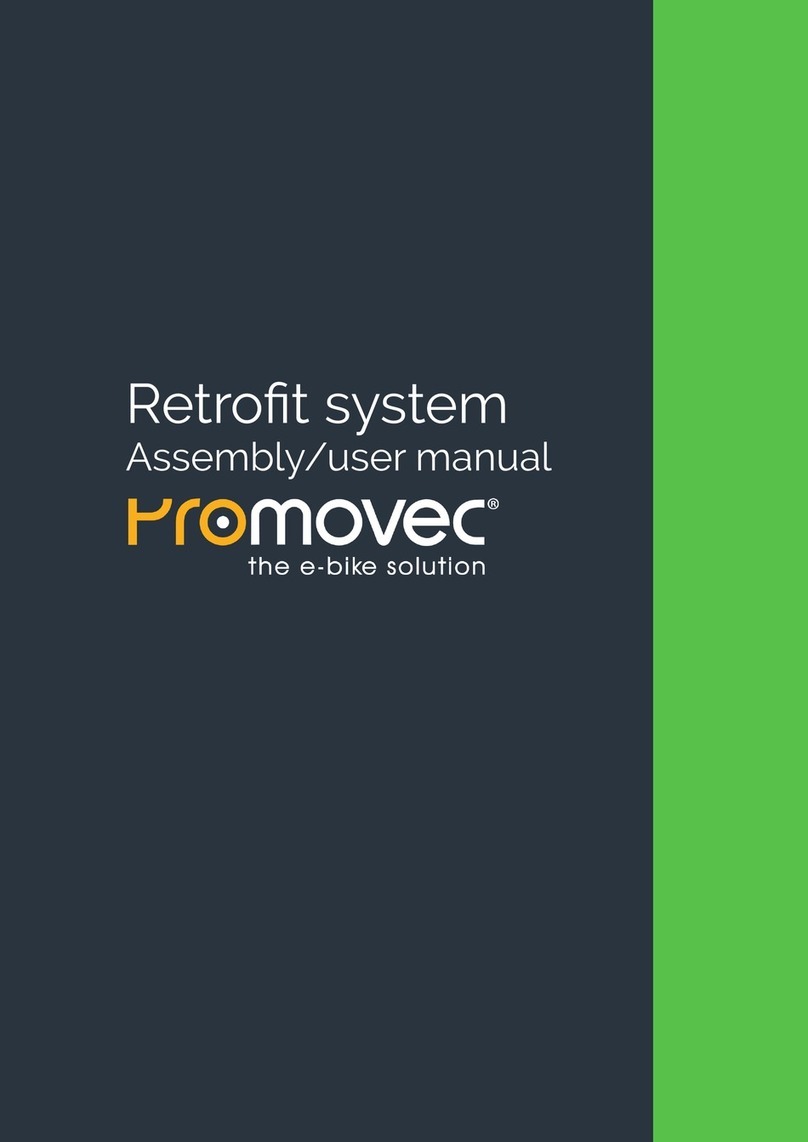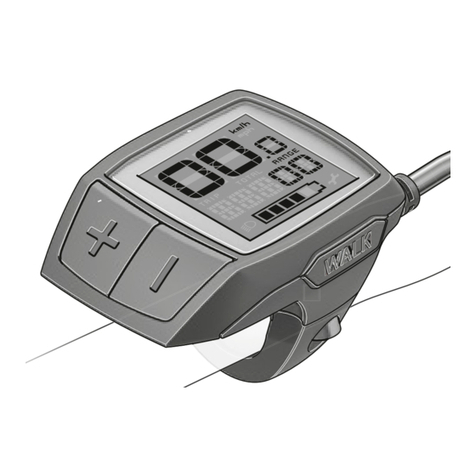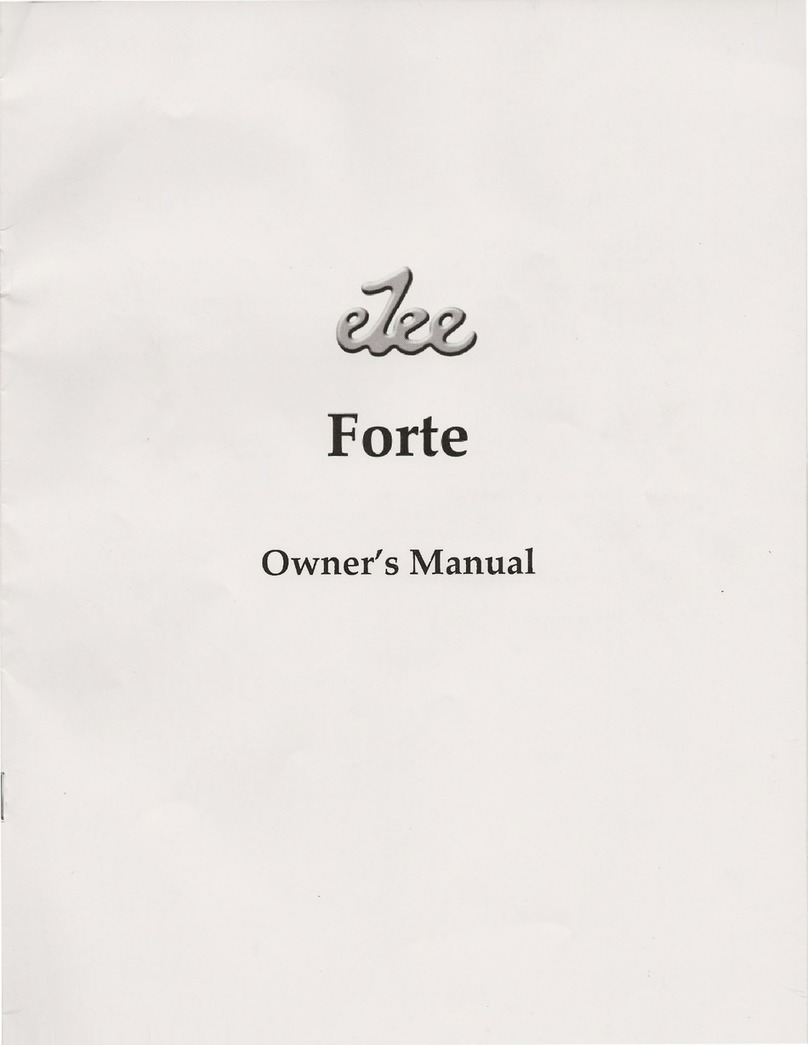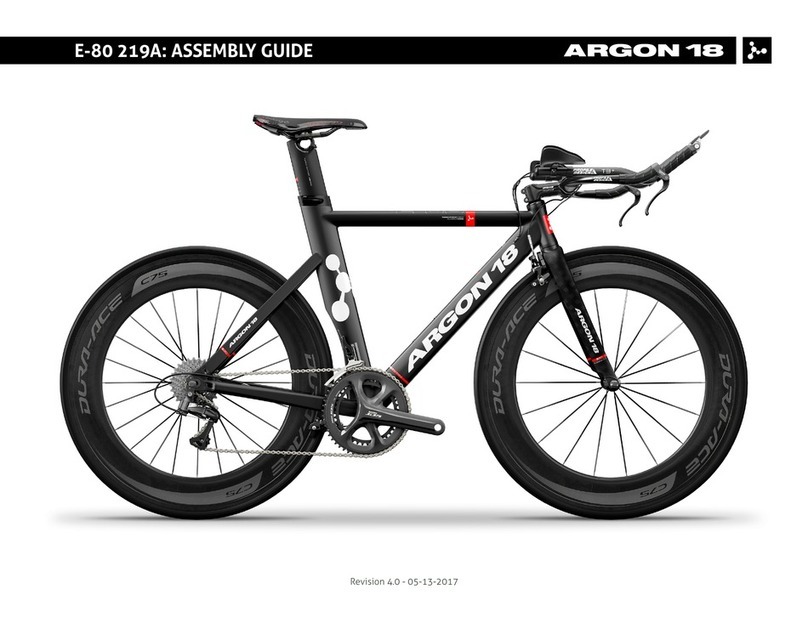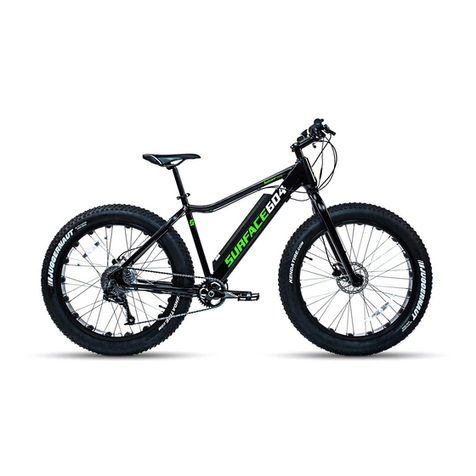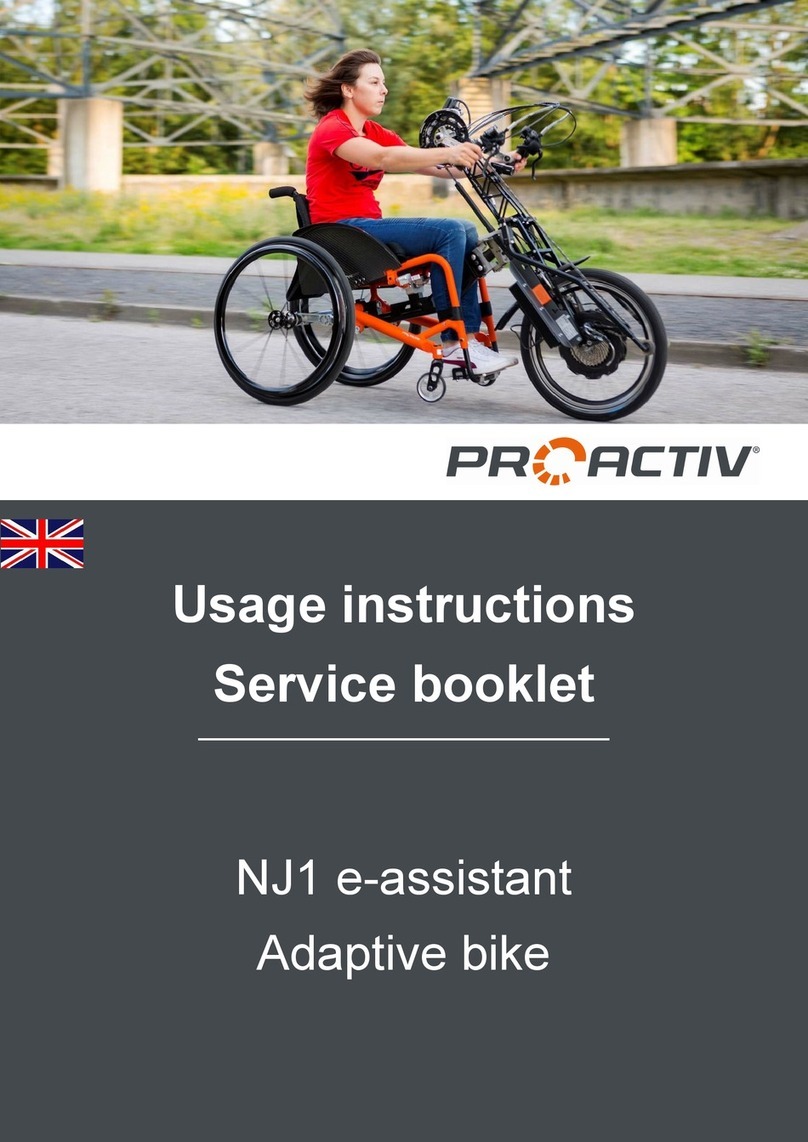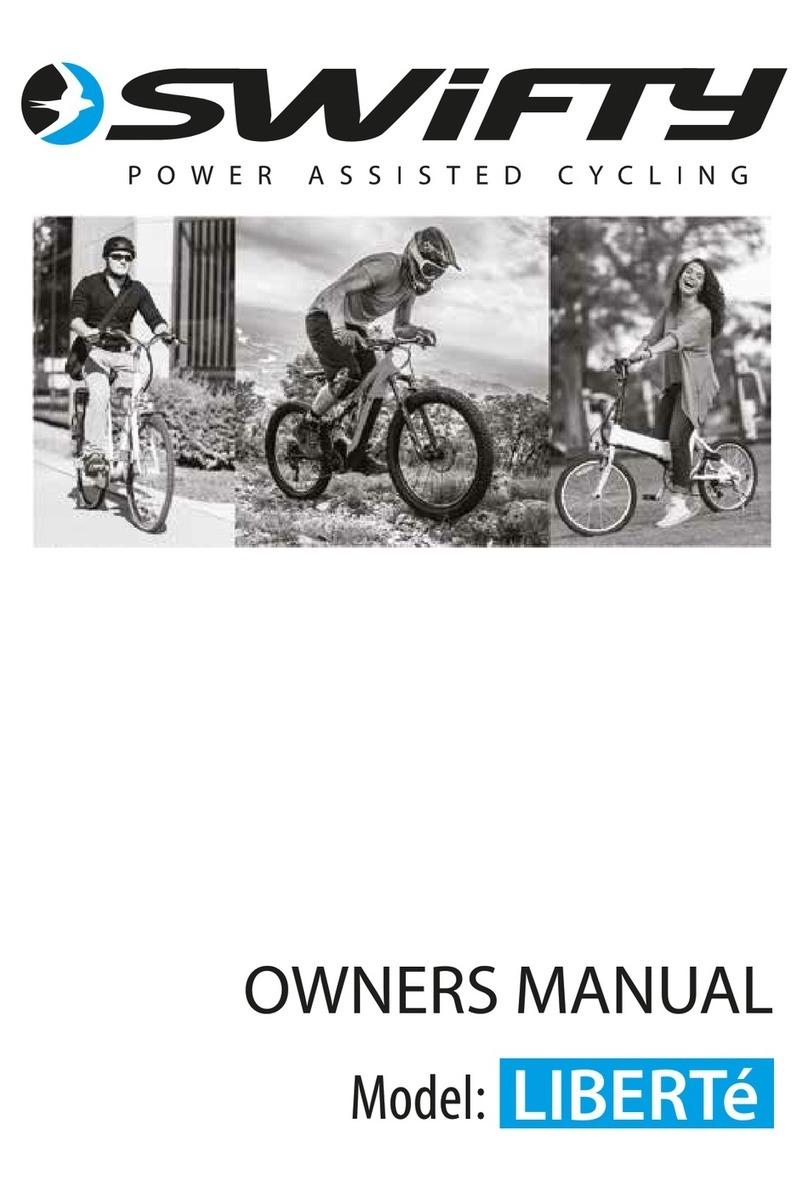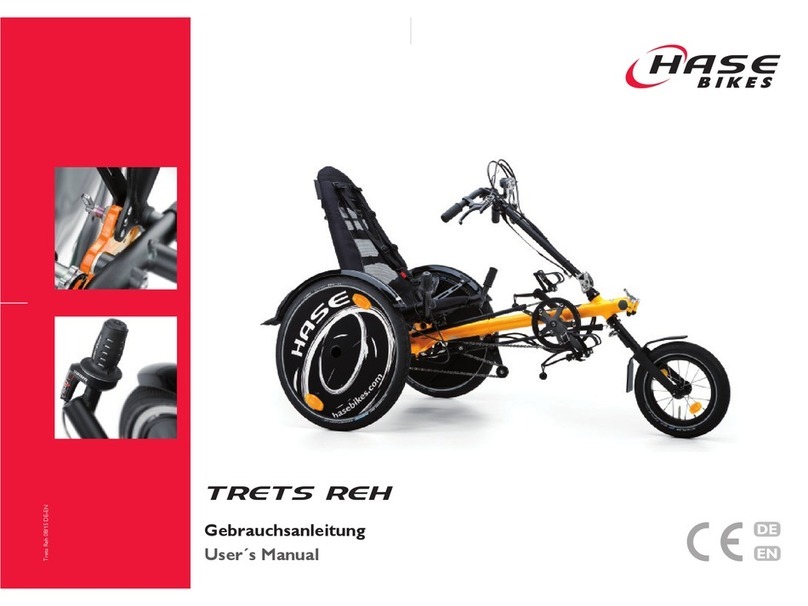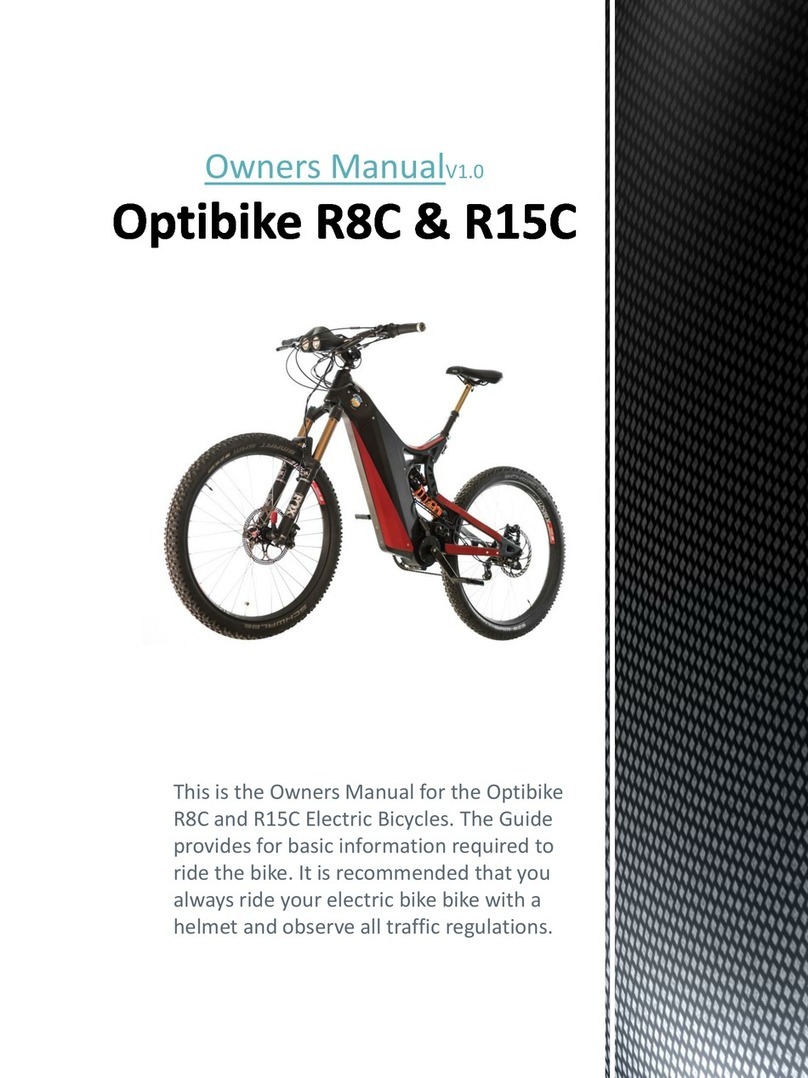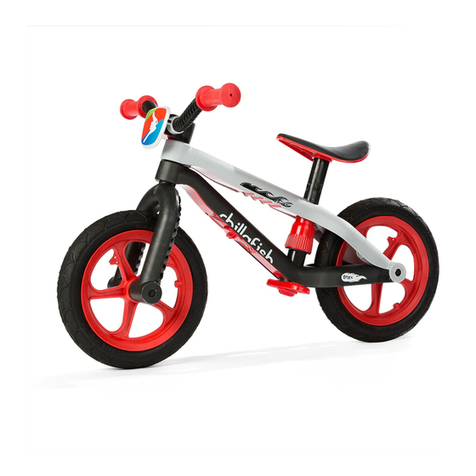Vitilan V3 User manual


PLEASE NOTE:
This manual is not intended as a detailed user, service, repair or maintenance manual.
Please seek assistance from a qualified technician for service, repairs or maintenance.
Importance……………
……………………………………………………………
P1
Models and Pictures
………………………………………………………………
P2,P4
Specifications
………………………………………………………………………...
P3,P5
Safety and Compliance with the Law
………………………………
P6
A
ssemblin
g
Your New e-Bike………………………………………………………
P7-P13
Operating Your New e-Bike
………………………………………………………
P14-P16
Intelligent Liquid Crystal Instrument
…………………………………………
P17-P34
Care and Maintenance
………………………………………………………………
P35
Safety
………………………………………………………………………………….
P36-P37
Trouble Shooting ……………………………………………………………………
P38

1
IMPORTANCE
When using the electric bicycle, basic safety precautions should always be
followed, including the following:
1. Read all instructions.
2. To protect against fire, electric shock and injury to persons, do not immerse cord,
plugs, or e-bike in water or other liquid.
3. Close supervision is necessary when the e-bike is used by or near children.
4. Unplug from outlet when not in charging and before cleaning.
5. Do not operate the e-bike with a damaged cord or plug or after the e-bike malfunctions,
or has been damaged in any manner. Take the e-bike to the nearest authorized service
bike shop for examination, repair or adjustment.
6. The use of accessory attachments not recommended by the e-bike manufacturer may
result in fire, electric shock or injury to persons.
7. Do waterproof when using on a rainy or snowy day.
8. Do not let cord hang over the edge of table or counter, or touch hot surfaces.
9. Do not place on or near a hot gas or electric burner, or a heated oven.
10. Always attach the plug to the battery first, then plug the cord into the wall outlet.
11. Do not use the bike for other than intended use.
12. Save these instructions.
*Note that this is a general manual. VITILAN reserves the right
to make changes to products and designs. The e-bike you own
may not be the same style as the pictures shown in this
manual.

2

3
Specifications
● MODEL: V3
● Frame Construction: Aluminum Alloy
● Wheelbase: 1117mm
● Gear Range: 7-speed type
● Tire Size: 20" (565mm)
● Climb Grade: 30 degree
● Max load: 150kg (330 lb)
● Max Speed: 31mph
● Power: 750W
● Battery Capacity: 48V 13.4Ah
● Battery Charger Input Voltage: 110/220 volt AC
● Battery Operational Temperature: 0°to 40° Celsius (32°to 104°Fahrenheit)
● Battery Life: Approximately 500 complete charge/discharge cycles
The following assumes an 60kg (133 lb) load (rider weight + any carry-on weight) on a flat
road,
Weather: 30℃:
Maximum Riding Range in Pedal Assist Mode 1: 40-55
miles
Maximum Riding Range in Hand Throttle Mode: 28-40
miles
at 20Km/h

4

5
Specifications
● MODEL: i7
● Frame Construction: Aluminum Alloy
● Wheelbase: 1200mm
● Gear Range: 8-speed type
● Tire Size: 20" (565mm)
● Climb Grade: 30 degree
● Max load: 150kg (330 lb)
● Max Speed: 31mph
● Power: 750W
● Battery Capacity: 48V 14.5Ah
● Battery Charger Input Voltage: 110/220 volt AC
● Battery Operational Temperature: 0°to 40° Celsius (32°to 104°Fahrenheit)
● Battery Life: Approximately 500 complete charge/discharge cycles
The following assumes an 60kg (133 lb) load (rider weight + any carry-on weight) on a flat
road,
Weather: 30℃:
Maximum Riding Range in Pedal Assist Mode 1: 45-62
miles
Maximum Riding Range in Hand Throttle Mode: 30-45
miles
at 20Km/h

6
Read This First: Safety and Compliance with the Law
Congratulations on your purchasing of your new e-bike. Your new e-bike is an excellent
piece of personal transportation equipment that will give you good service for many years.
Before you start using your e-bike, we want you to be aware of a few important points.
Please read this section carefully.
● Observe Laws Regarding the Use of Battery-Operated Bicycles
Your e-bike is designed and manufactured to meet safety requirements as a battery-
operated bicycle. However, state and local laws governing the use of battery-operated
bicycles on public roadways, parks, and other open areas may differ. Please check
with your local authority before using your e-bike in public areas.
● Observe Laws Regarding the Use of Bicycles
Note that all laws regarding the use of bicycles in public areas, such as those
mandating the use of helmets and the use of infant seats, will automatically apply for
e-bikes. Check with your local authority on what restrictions might apply.
● The Lithium-ion Battery of Your e-Bike
Your e-bike is equipped with the latest battery technology. The lithium-ion battery is
much lighter than lead- or nickel-based batteries that are being used in some older
models.
● Your First Ride
Please be VERY CAREFUL when you are ready to get on your e-bike for the first time
because that the e-bike moves significantly faster than a regular bicycle at active power-
assisted mode. Take your e-bike to an area with a lot of open space before you start.
Do not start pedaling hard as soon as you get on the e-bike (as you normally would be
with a regular bicycle), as the e-bike will accelerate under pedal-assist mode and you
may be unprepared for the sudden increase in speed. However, after a few times, you
will enjoy using the pedal-assisted function.

7
Assembling Your New e-Bike
If you purchased your e-bike unassembled, please follow these instructions to assemble
your e-bike under the guidance of an adult or a qualified technician. Assembly is quite easy
as most of the parts are already assembled; you need only to put a few pieces together to
complete the job.
For more information. Please refer to the following way:
Facebook: Vitilanebike Youtube: Vitilanebike
Instagram: Vitilanebike Twitter: Vitilanebike

8

9

10
Air Shock Absorption Front Fork

11
Check that the Package is Complete and Undamaged
Your e-bike comes in a carton containing the following:
The main body of the e-bike – consisting of the frame, the front and rear
wheel, the gear and chain, the front and rear brake, the battery on the
frame, the rear fender.
The handlebar subassembly with the battery’s keys that attached on it –
the handlebar subassembly is not really separate, as it is connected to the
main body by the brake cables and electrical wires. The handlebar also
has the brake levers and gear control already assembled. Additionally, the
handle also has an integrated control for the throttle mode power-
assisted, a display panel.
The Seat – the seat is attached to its pedestal stem.
Tools and other parts –tools, one charger, a pair of foot pedals and this
manual, they are contained in a separate box.

12
Assembly - Step 1: Attach the handlebar subassembly
Stand the main body of the e-bike on the kickstand. Stand up and lock the steering
column that is at the front of the main body frame, insert the stem of the handlebar
subassembly into it. Make sure that the fork (that will hold the front wheel) is pointing
forward, and orient the handlebar accordingly. Insert the stem all the way and tighten
from the top using the quick lock.
Assembly - Step 2: Installing the Seat and Pedals
Insert the pedestal stem of the seat into the seat column of the main body frame, use
the built-in lever to tighten.
Attach a pedal on each side of the crank, note the distinction between left pedal and
right pedal, tighten with the multi-tools.

13
Inflate the tires to proper pressure.
At this point, your e-bike is a completely functional bicycle, although without any battery
operated to function as yet. Check all tightening points to make sure. Take a short ride.
Adjust the height of the handlebar, and the height and the tilt of the seat, if necessary,
for maximum comfort.
Assembly - Step 3: Charging the Battery
Take out the charger from the box, attached the power cord and insert that to any wall
outlet. Insert the plug at the end of the smaller cable into the charging terminal of the
battery and start charging. The charging terminal is on the side of the battery opposite
to a hole on the side of the frame. The LED on the charger glows RED while charging
and glows GREEN when charging is complete. The battery should be turned OFF while
being charged. When the LED on the charger turns Green, disconnect the charging
cord and cover the charging terminal with the rubber cap. If a battery is installed on the
e-bike and turned ON, the display panel will show the charge level of the battery when
the bike turned ON.
You are now ready to start using your e-bike.

14
Operating Your New e-Bike
The method to turn on the bike is:
I. Twist the battery lock counterclockwise to the end to turn on the battery;
II. Press power button on the left handle bar until the display lights on;
III. Ride on the bike and twist the throttle bar or pedal the bike, the bike will move, you can
change the power level with control buttons, level 1 is the slowest and level 5 is the
fastest, level 0 is human model.
Your e-bike is driven by a motor embedded in the hub of the rear wheel. The motor is
powered by a battery. The amount of power delivered to the motor, and hence the
accelerating force on the e-bike, is controlled by you in a way according to the power-
assisted mode or full power mode you choose.
You can configure the e-bike to operate in the pedal-assist-only-mode or the full power
mode (should check against local laws to ensure full power mode is permitted) where you
can also use the hand throttle to deliver power to the motor.
Your First Ride
(Reprinted from the Safety and Compliance with the Law section)
Please be VERY CAREFUL when you are ready to get on your e-bike for the first time
because the e-bike moves significantly faster than a regular bicycle at active power-
assisted mode. Take your e-bike to an area with a lot of open space before you start.
Do not start pedaling hard as soon as you get on the e-bike (as you normally would do
with a regular bicycle), as the e-bike will accelerate under pedal-assist mode and you
may be unprepared for the sudden increase in speed. However, after a few times, you
will enjoy using the pedal-assisted function.
Pedal-Assisted
You must turn on the battery to use the e-bike in pedal-assisted mode.
In the pedal-assisted mode, power assist is triggered when you pedal forward, and
power assist stops when you stop pedaling, sometime would be delay. In other words,
power assist happens as long as you pedal. You don't need to pedal hard. All you need
is to apply a light force to the pedals continuously to maintain the current flow. When
you apply one of the brakes, power assist will automatically stop, allowing the e-bike to
slow down and stop. Power assist will turn itself off when the e-bike has reached the
maximum speed that the power level you choose.
You should use the gear shifter at the handlebar to set the gears appropriately
according to road conditions and pedal, as usual, you will find that you need to exert a
lot less effort and the e-bike travels faster and at a more steady speed.

15
Cruise Control
Cruise Control will be triggered when you holding thumb throttle for 8 seconds, and it
will be released by braking/pedaling or throttling.
Thumb throttle Control
In the hand throttle mode, amount of power assist is determined by the throttle switch
controlled by your left hand. You control the throttle by twisting it from its resting
position, the farther the throttle switch is from its resting position, the more power is
delivered to the motor to accelerate the e-bike. When you want to slow down, you
simply release the throttle and let it return to its resting position, and simultaneously
apply the brakes if necessary.
You do not need to pedal the e-bike if you use the hand throttle. However, you can
pedal while commanding power assist. If you do pedal to help the movement, you
conserve energy and the charge in the battery will last longer.
Charging Your e-Bike Battery
Your e-bike battery is a lithium-ion battery. Lithium-ion battery requires specially
designed chargers. You should never charge your battery with a substitute charger
that is not designed for this use. Use of an unsuitable charger to charge a lithium-ion
battery will result in overheating, fire or even explosion. Ensure charger voltage is
consistent with battery voltage. If your charger is lost or damaged, contact your dealer
to order a replacement.
Charge your battery while the e-bike is not in use. You should turn off the battery
before you charge it. You may charge your battery while it is mounted on the e-bike, or
after it has been removed from the e-bike.
Do not place either the charger or the battery near flammable substances while
charging is taking place. Charging should not be done in the vicinity of infants and
small children. It is also prudent to remove valuable objects from the immediate
vicinity of the battery while it is being charged. Don't charge in unattended condition
for a long time. For the safety of you and your family, it is recommended not to charge
in the middle of the night.
In order to maintain battery life, do not charge until the battery completely discharged,
it is recommended to start charging when the power is less than 20 percent. If the
battery will not be used for an extended period of time, charge it fully and recharge it
every month. If not used for several months, the battery may be completely self-
discharge and unable to charge.
The length of charging time depends on the level of charge the battery still holds. If a
battery is completely discharged, it will take 6 hours to be fully recharged.
When a battery is fully charged, the LED on the charger will transition from RED to
GREEN. At this point, you should disconnect the charger. Do not leave the charger

16
connected to the battery for a very long period of time after charging is complete.
(Leaving it connected for an overnight charging is OK.)
It is normal for the charger and the battery to be slightly hot while charging is on-going.
Removing the Battery from the e-Bike
The battery is an important and costly part of the e-bike. It is designed to be locked into
position with a key to preventing theft. You can take further precaution by removing the
battery while the e-bike is parked unattended. You may also have a need to remove the
battery from the e-bike to recharge it at a location where you cannot park your e-bike.
The method to remove the battery is:
I. Open the cap of the charging port and fold the bike;
II. Insert the key into the battery, hold pressing the key a bit until twist clockwise to the
end (Note: You can’t remove the battery until the lock bar withdraws into the battery
completely);
III. Slip off the battery, the battery is quite heavy and you should take care not to drop
it.
Maximizing the Riding Range
Many factors affect the rate of use of the electrical energy and the riding range.
You should fully charge the battery before a long journey.
Rough road conditions and hilly terrain will consume more energy.
Frequent change of speed will consume more energy.
Carrying more weight on the e-bike will consume more energy.
Keeping the tires properly inflated and keeping the e-bike clean and well
lubricated will save energy.
Making sure that both wheels move freely when brakes are not applied will save
energy. You should check brake adjustments frequently.
Pedaling as you ride will consume less electrical energy and increase the riding
range.
When the battery is turned off, your e-bike functions as a regular bicycle. If you
embark on a very long journey, you might want to turn off the battery for long
stretches where the road is level or downhill and pedal the e-bike as a regular
bicycle so that you can conserve electrical energy stored in the battery.

17
Intelligent Liquid Crystal Instrument
Specification Parameters:
● Model: YL80C.
● 24V/36V/48V power supply
● Rated working current of instrument 10mA
● The maximum working current of the instrument is 30mA
● Shutdown leakage current < 1uA
● The operating current supplied to the controller is 50mA
● Working temperature-20 ~ 60 ℃
● Storage temperature-30 ~ 70 ℃
Physical Drawing and Dimensional Drawing (unit: mm)

18
Functional Overview and Functional Area Distribution
◆ Function Overview
● Electricity Display
● Motor power indication
● Boost gear adjustment and indication
● Speed display (including real-time speed, maximum speed and average speed)
● Mileage display (including single mileage and total mileage)
● Assist in implementing control and display
● Backlight control and display
● Error Code Display
● USB Connection Indication (Option)
● Heart Rate Display (Option)
● A number of parameter settings (e.g. Wheel diameter, speed limit, battery power
setting and assistance parameter setting, startup password setting, controller current
limit setting, etc.)
● Default parameter recovery function
◆ Functional Area Distribution
This manual suits for next models
1
Table of contents

